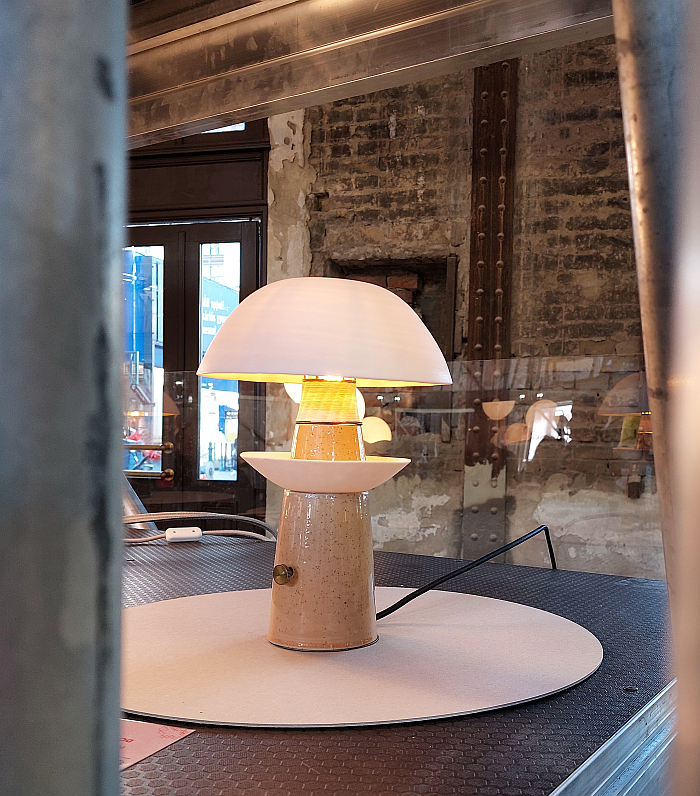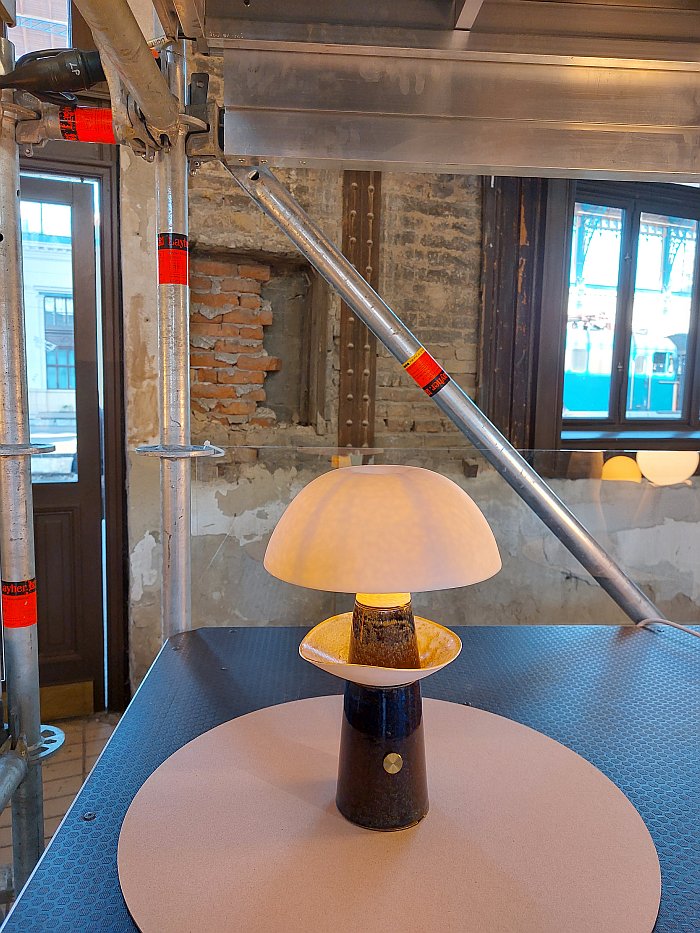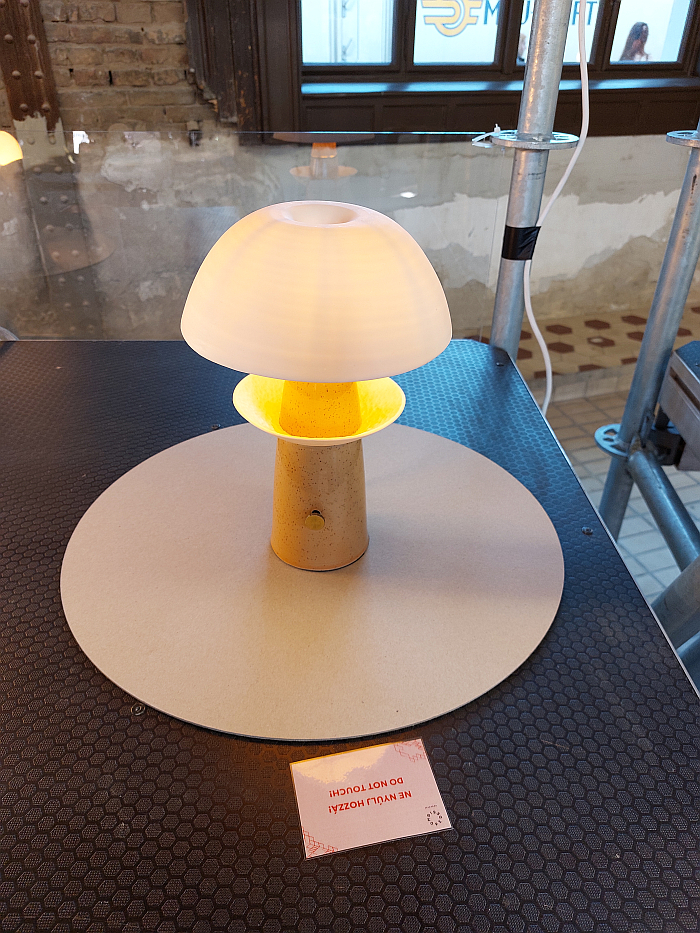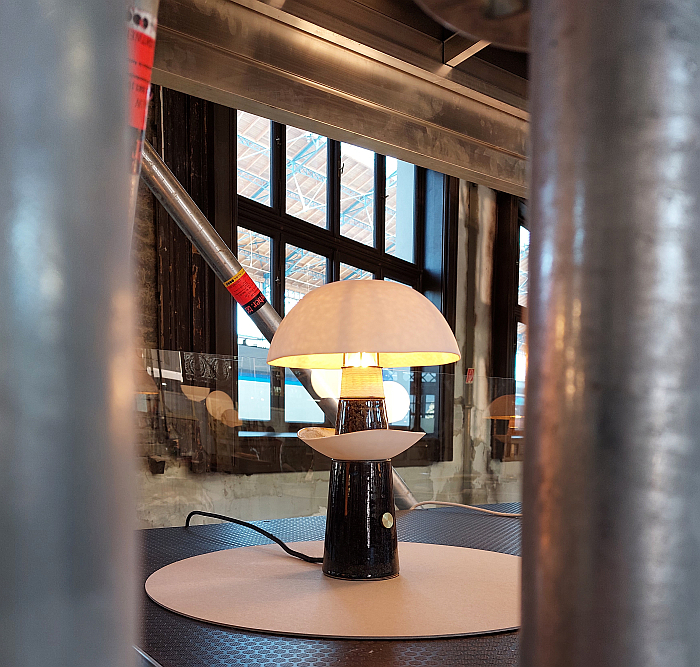
Before we go any further.... Uniqueness in Mass Production isn't the name of Moholy-Nagy University of Art and Design, MOME, Budapest graduate Fehérvári Panna Nóra's lamps.
Panna calls them MushLume, for understandable, and highly enjoyable, reasons, but sadly MushLume is the name of a Brooklyn, New York, based manufacturer of lighting crafted from mushroom mycelia, and so it's unlikely to remain their name for very long, unless that is MushLume USA take on the production of MushLume HU.... it would appear predestined. But in case they don't, and to avoid any unnecessary Vitra vs. VitrA confusion, we're calling them Uniqueness in Mass Production which was the name of Panna's 2024 Masters thesis at MOME from which the lamps arose, pinned.
A Masters thesis that, as best as we can ascertain without having read said thesis, approached the question of how one achieves, well... uniqueness in mass production, that question that arguably has busied creatives since it became unmistakably clear that while replacing craft production with industrial production brought benefits and enabled new possibilities, it also brought new problems and exposed new limitations.
And brought us the monotony of mechanical uniformity.
A uniformity that is essential for rationalising and optimising production, a core demand of providing for a growing global population in context of a global economic system, the neatest example, arguably, being the millions of identical plastic monobloc chairs pressed globally every day; but as users we don't demand uniformity in our products, we demand functionality, responsiveness, durability, reliability, an opportunity to establish a relationship with an object. The latter of which, arguably, requires a degree of individuality in our objects of daily use akin to the individuality found in the human species. Not in all our objects of daily use, the contemporary material world is too complex for that, a William Morris could argue for craft production with its personal connections and uniqueness of result because of the relative simplicity of the late 19th century, he'd be at a real loss in the 21st century; not all our contemporary objects of daily use could benefit from breaking from the monotony of mechanical uniformity, but some.
But how do you achieve the uniqueness that craft inherently brings with machine production?
As we all recall from Der ungesehene Designklassiker at the Deutsches Stuhlbaumuseum, Rabenau, the DDR achieved it unwittingly, unintentionally, with the EW 1192, the best selling chair in the DDR, an object that was produced at various locations around the DDR, with each factory making their own changes in order to adapt it to their machines, skill sets, processes etc and thereby producing individual interpretations of Horst Heyder's design... But for all the variety within the EW 1192, all those chairs from one location were uniform.
And Fehérvári Panna Nóra? How does Fehérvári Panna Nóra propose achieving the uniqueness that craft inherently brings with machine production?

Admittedly were not 100% sure: on the one hand we've not read her thesis, that thing that one needs must do to fully understand her argumentation; on the other the Uniqueness in Mass Production lamps we saw at 360 Design Budapest were unhelpfully secured behind plastic screens at a really awkward height which made getting up close and personal with them, real difficult, as in impossible. One of numerous highly improbable display positions 360 Design somehow considered suitable for works of design. To which we shall return. And on the rare third hand, we had hoped to get a little more information from the showcase Best of Forma - Selected works from MOME Product Design students, but for reasons we can't begin to comprehend it is being staged in a venue that is closed at weekends — why would you do that? And why would you close an exhibition that's only on for a few days, in context of a design week, while that design week is still on? Is that design week not exactly the window MOME hoped to exploit? Why shut that window? And guess who'd scheduled to visit it on a weekend day? Guess who delights in any and every student showcase, in the insights and positions of students? Guess who is on a MOME project's trail? Had we known we would have gone earlier, but in order to know something that information must be provided, for example on the Budapest Design Week website, which is isn't... but that's a subject for another day..... we had had hoped to get a little more information from the showcase Best of Forma - Selected works from MOME Product Design students but were unable to view that showcase for (thoroughly unjustifiable) reasons outwith our control.
Therefore we are, despite the subject at hand, grasping a little in the dark here... but the primary sources of possible variation appear to be (a) the glaze of the ceramic body, which we're assuming isn't straight colour differences but rather the fact that craft glazing, and firing, rarely produces an identical result, and depending on how the glaze is applied the differences can be considerable (b) the ceramic lamp shade, whereby we're admittedly not sure how those differences materialise and are expressed, but are on the trail of those answers, and (c) the 3D printed ceramic diffuser, a component that was essentially hidden from us at 360 Design, but which does bring us to that, for us, key to uniqueness in mass production: digital technology. Not just 3D printing, although for us that is of central importance, not least in the ceramic Panna employs, but the many digital tools we have, and will have more of, that (will increasingly) allow for (near) instantaneous changes to production systems allowing for (near) conveyor belt supply of unique objects and/or custom objects.
And thus, as far as we can judge, which could be wrong, an approach to bringing uniqueness to mass production proposed by Panna that sets equal value on serendipity and control, on nature and nurture, on the vagaries of the human and the infallibility of the machine, on things that have always been and on things still to come. And thus a proposal, an approach, that appears to offer access to alternative appreciations of what the much vaunted Industry 4.0 could be, how it could reset (some of) the negative impacts of Industry 2.0, how it could relate to contemporary society while remainig responsive for a future society we can have no knowledge of.
What we do know is that after undertaking all the research for her thesis Panna presented "the potential paths to uniqueness I identified in a Venn diagram": in a world where decisions are increasingly made by machines via algorithms and AI, in an age where algorithms and AI could propose "potential paths to uniqueness", Panna used a Venn diagram. A format, a tool for decision making, of which we very much approve, for a great many reasons, not least because it's essentially a craft process, has a human element, reminds that while all technology is without question useful, it isn't the only option, there are others, often more elegant and meaningful options, that we always need to weigh up the pros and cons and make active decision as to what we employ. A Venn diagram we very much hope to see some day. And a Venn diagram that alone is enough to get the Uniqueness in Mass Production lamps in these dispatches.
But the Uniqueness in Mass Production lamps are a lot more.

Visually the lamps are the most incongruous things we've seen in a long, long time, which struck us as perfect for our contemporary society; the individual elements individually all appear wrong, nothing seems to work, question marks abound... and all come together in a thoroughly joyous, engaging, coherent, self-confident whole. Which may or may not be a metaphor for contemporary society that is well worth reflecting on.
Or put another way, at first glance the lamps appear to be the result of an exercise in upcycling, but would be truly awful, unbearable, if they were; that they are visually so convincingly is, for us, without knowing all the details of their development, because although each individual component has been approached and developed individually, that approach and development was always in context of the whole, there's certainly a communication between the individual components in which each is aware of their responsibility to the other and each understands that the finished object must be more than the sum of its parts. A communication that is continued with the viewer/user.
Functionally, while we're admittedly unsure how you change the light bulb/source, if you can change the light bulb/source, the type of light bulb/source, hidden away as the lamps were at 360 Design, there is a small brass knob which not only deliciously adds to the incongruity but may or may not be a dimmer. And the lamps all feature a ceramic bowl below the shade which on the one hand, we presume, viewing any lamp in any such space is never ideal, will, at least partially, reflect a portion of the illumination in a variety of more or less random directions thereby supporting the agency of the lamp, but also provides storage space for small things: Panna suggests jewellery, which leads us to associate the lamps with bedside tables, but any number of small, light insensitive, objects would also fit in the bowls on a hall table, a dressing table, a kitchen table, a sideboard, a wherever, it's a lamp with no fixed abode.
Yes, the functionality of any lamp is also a question of the illumination they supply, that is the primary raison d'etre of any and every lamp, they were on at 360 Design, but in a very bright space with a lot of windows on a bright sunny day ¯\_(ツ)_/¯ ; however given the patterned porcelain shades its not going to be a intense, directable technical light for, say, a library reading corner; but then they are very much intended as providers of ambient background light, as being emotionally functional more than technically. And from what we've seen of them we see no reason to doubt they can provide that.
But ultimately such a student graduation project isn't about the lamps, charming as they are, is never about the object realised, they are but an attempt to bequeath the research undertaken a tangible form, the more important part is the conclusion Panna reached, Panna's Venn diagram, and that's in the thesis, if MOME could take a leaf from the Eesti Kunstiakadeemia, Tallinn's, book and publish all theses online, that would be great. Thank you.
And such a student graduation project, as we will never tire of opining, is never, ever, about the object, or even the thesis that results, but about what the student got from the experience, how the development of the project, the challenges, the fresh insights, the conversations, the innumerable diversions along the way, the journey undertaken, informed their positions on and approach to design, how the experience of the project saw them question and re-approach their appreciations of design, the function of design, the necessity of design, the relationships between design, and designers, with wider society, the responsibilities and risks of design, and designers. And that will become clear in the years to come. As will the future of the Uniqueness in Mass Production, a.k.a. MushLume, lamps.
As best we can ascertain Fehérvári Panna Nóra doesn't have a website, but her Instagram channel can be found at @pannafehervari
And her MOME Diploma page at https://diploma.mome.hu
For all in or near Budapest, the Uniqueness in Mass Production, a.k.a MushLume, lamps, and all other selected works, can be viewed and enjoyed at 360 Design, Nyugati Railway Station, 1062 Budapest, Teréz krt. 55 until Sunday October 20th.
Full details can be found at https://360dbp.com
And full details on Budapest Design Week 2024 can be found at https://hfda.hu
